The Clevo P870DM2 / Mythlogic Phobos 8716 Laptop Review: DTR With GTX 1080
by Brett Howse on October 27, 2016 2:00 PM ESTSystem Performance
Although there are several processor options in the Clevo P870DM2, Mythlogic has outfitted the review unit with the highest performance model they offer: the Intel Core i7-6700K. For those familiar with Intel’s lineup of processors, they offer several model lines, with the lowest power ones being the Y series, which are 4.5-Watt, and then the 15/28W U series, and then the highest tier of their mobile processors in the H and HQ, with the latter being the quad-core mobile parts. These top out at 45-Watts, and we see them in almost all gaming laptops. Clevo is marketing this as a desktop replacement, and as such, every processor option is from the Desktop lineup. The majority of the processor options are in the 65-Watt series from Intel S lineup, featuring quad-cores and 6 MB of cache. The processor in the Phobos 8716 review unit is from the K series, with a 91-Watt TDP, 4.0-4.2 GHz, 8 MB of cache, and it is unlocked for overclocking. From a power perspective, the Core i7-6700K has just over twice the thermal headroom of a typical H series processor found in a gaming notebook. Twice the TDP doesn’t mean twice the performance, of course, but there is certainly a lot more potential performance on tap than any H series could offer.
To see how much performance is available, the Clevo P870DM2 was run through our standard lineup of tests, and then compared against several other systems. Of particular interest will be comparisons against the last Desktop Replacement notebook that we tested in the Clevo P750ZM, which was outfitted with the Devil’s Canyon Core i7-4790K, and that CPU actually has a slight frequency advantage over the i7-6700K, with the former topping out at 4.4 GHz and the latter at 4.2 GHz, but with the advantage of the Skylake architecture versus the Haswell architecture in Devil’s Canyon. As always, check out our notebook bench if you’d like to compare this laptop to any other we have tested.
PCMark

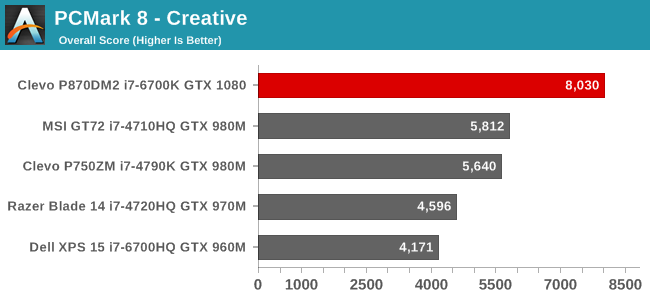

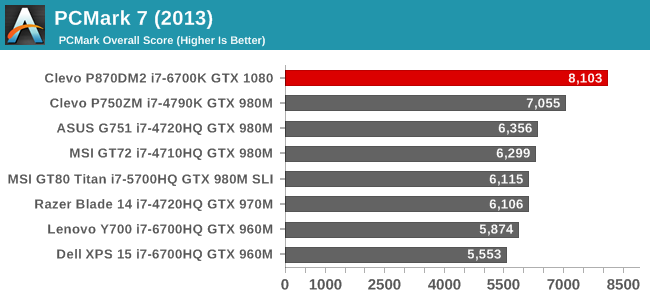
Our first tests are from Futuremark’s PCMark benchmark. This test runs through several real-world applications, and is a complete system test, from the storage to the CPU to the GPU. The Phobos 8716 sets a new bar here for performance in a notebook. That’s not surprising since it has the fastest CPU, the fastest GPU, and the fastest SSD in the Samsung 950 Pro.
Cinebench
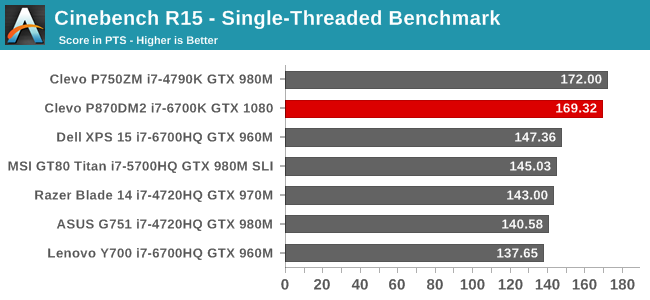
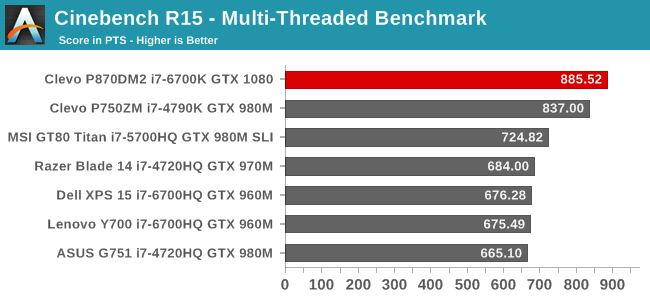
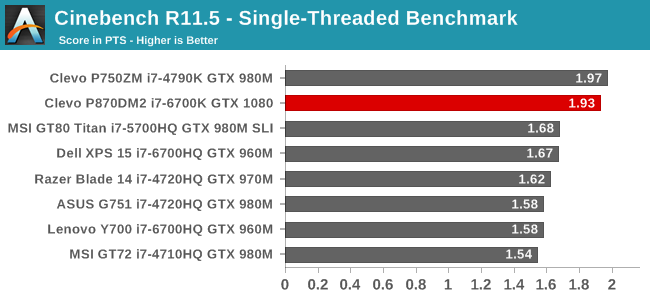
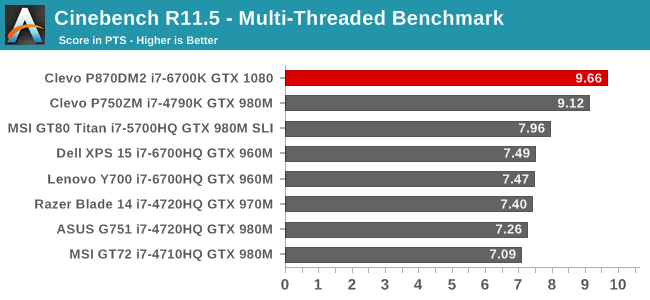
This test tends to be focused on pure CPU performance, and more cores with higher frequencies tend to dominate on this test. We can see that as well with the Devil’s Canyon in the P750ZM slightly edging the Skylake i7-6700K, thanks to a higher turbo frequency available, but only on the single-core tests. On the multi-core tests, the Skylake pulls ahead with its more advanced multi-core turbo, and benefits like Speed Shift.
x264
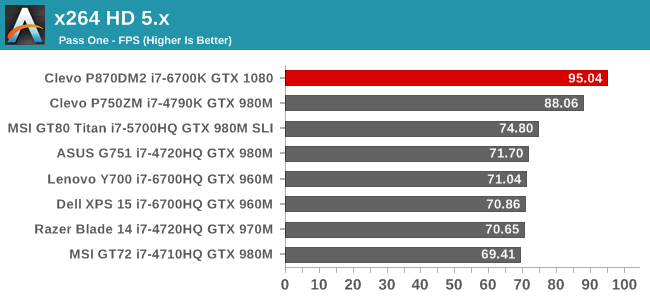
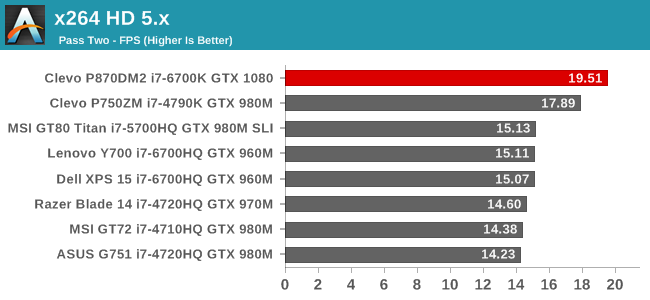
The better multi-core performance of Skylake once again pulls ahead easily here, with performance significantly better than the Haswell Devil’s Canyon.
Web Tests
Finally, web performance is always a priority, although it can be heavily influenced by the browser and platform. It is still something that everyone does every day. When Windows 10 launched, we switched to Edge for our tests, from Chrome on previous versions of Windows. Each browser is marked in the results.

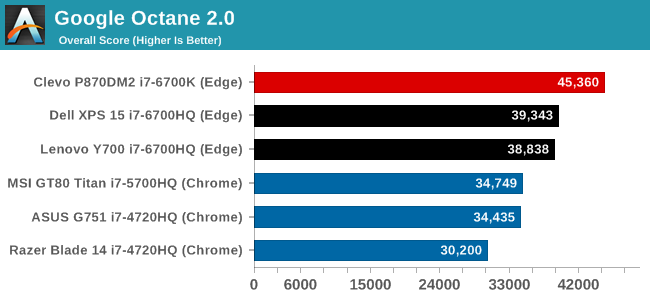


It should come as no surprise after the previous benchmarks that the Clevo P870DM2 / Mythlogic Phobos 8716 easily trounces all previous computers on our web benchmarks as well. Packing a desktop CPU into a notebook has some drawbacks in terms of heat dissipation, but at the end of the day the performance is a good jump ahead of any of the H series processors.
Storage Performance
As with any of these boutique computers, there is quite a bit of customization available on all of the components, and the storage is no exception. For the review unit, Mythologic supplied the Samsung 950 Pro NVMe SSD, and if you saw the review on that drive, you’d be aware that it is one of the fastest consumer SSDs available today, and in fact was only recently pipped with the introduction of the 960 Pro.
With the 256 GB model which is in the review unit, there are not the maximum amount of NAND dies to give the maximum performance, but regardless the results are still very, very good. Read rates approaching 2000 MB/s is likely going to be enough for almost anyone. Mythlogic will outfit the Phobos 8716 in multiple ways, and there are actually two M.2 slots if you need more SSD storage, and also two 2.5-inch SATA slots as well if you need a bit more bulk storage for game downloads.


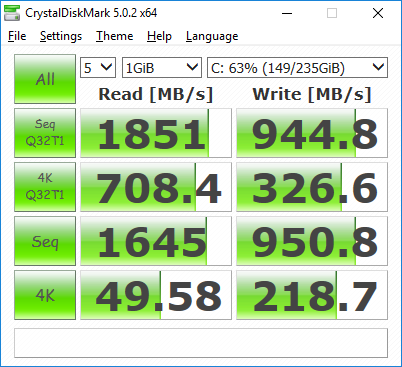








61 Comments
View All Comments
Drumsticks - Thursday, October 27, 2016 - link
The Surface AIO is not really a great choice for gaming. It's more a "Compete with Cintiq" type device, where they can get away with selling a 27" QHD touch+pen monitor for $2800.ZeDestructor - Thursday, October 27, 2016 - link
If the Surface AIO came in monitor-only form, I'd give it some pretty hefty consideration for use during onenote/collab sessions/RPG mapping and such.andychow - Thursday, October 27, 2016 - link
A 12 lbs laptop that has a battery life of one hour. Let's be real, you aren't moving this thing around. Just buy a desktop.RaichuPls - Thursday, October 27, 2016 - link
It could be useful as a product for somebody who moves around often, traveling a lot and using it in a hotel etc.Dribble - Thursday, October 27, 2016 - link
There's definitely a sliding scale of portability going from phone -> desktop. This sits between ultra book, and mini desktop pc. You're not going to use it on the train/plane, but it still fits in a laptop bag - you can take it too hotels, or even just take it on/off the kitchen table easily. While power isn't going to last on battery it will run for a while which is often enough.On the downside they are loud - anything 49 db new is going to get annoying loud when the fans clog up with dust. It's also hard to upgrade gpu's - you can upgrade memory and hd's easily enough, and these days the cpu is good for life but gpu's are still moving forward fast and you can end up with a laptop that is pretty current in everything but gpu performance after a few years.
ZeDestructor - Thursday, October 27, 2016 - link
At least you can upgrade the GPU, and by the looks of it, this has all the provisions to reliably feed 180W MXM-based modules for a long time too.TheinsanegamerN - Thursday, October 27, 2016 - link
assuming the BIOS can support newer GPUs, which is incredibly hit or miss.ZeDestructor - Friday, October 28, 2016 - link
Clevos are known to support it, by specifically not doing any UEFI/vBIOS level hackery. Basically just slaps the card in and routes out the extra DP connectors from the MXM slot to the physical ports and screen. Very desktop-style.bji - Thursday, October 27, 2016 - link
It would make a fine portable VR rig for those with lots of money to burn. I built a portable ITX system for about half the cost of the laptop, but there is no doubt that the laptop is even more portable and certainly much slicker with its built-in display, keyboard, and pointing solution (which are all separate components in my ITX build obviously).Only problem is that you can upgrade the ITX system with a new graphics card, but with the laptop, the graphics card you get is the only one you'll ever have.
doggghouse - Thursday, October 27, 2016 - link
Actually, one of Mythlogic's features is their Lifetime Phoenix Upgrade Plan, which lets you send your laptop back to them and upgrade whatever hardware you want. Assuming they are using some fairly standard components (Clevo?), you could in theory take your laptop with a GTX 780M card and upgrade it to GTX 1080 (or even go with a Radeon?!). I haven't seen reviews of how well it works, but I really like the concept. I personally have an Alienware laptop from 2011, and have seen people use some BIOS hacks to make newer GPUs work, since Dell sells some of those parts directly. I imagine if the company actually supported it, the concept would work even better!